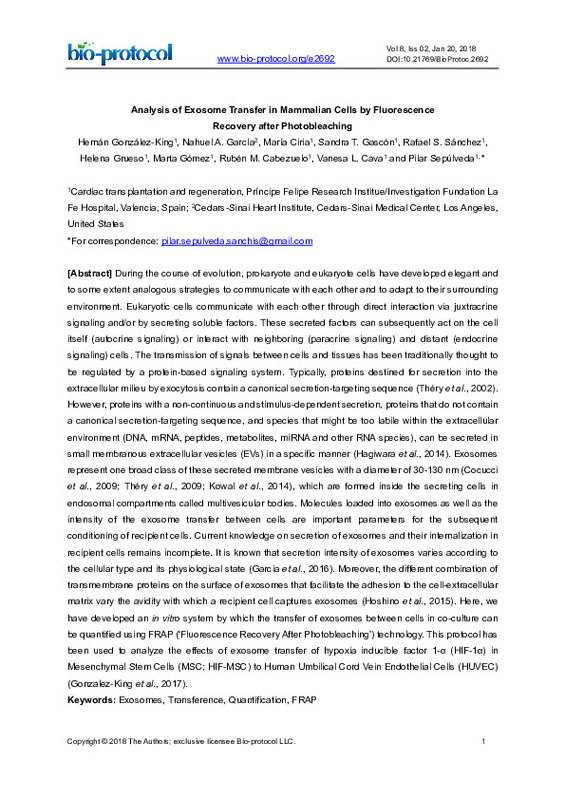JavaScript is disabled for your browser. Some features of this site may not work without it.
Buscar en RiuNet
Listar
Mi cuenta
Estadísticas
Ayuda RiuNet
Admin. UPV
Analysis of Exosome Transfer in Mammalian Cells by Fluorescence Recovery after Photobleaching
Mostrar el registro sencillo del ítem
Ficheros en el ítem
| dc.contributor.author | González-King, Hernán
|
es_ES |
| dc.contributor.author | Garcia, Nahuel A.
|
es_ES |
| dc.contributor.author | Ciria, María
|
es_ES |
| dc.contributor.author | Gascón, Sandra T.
|
es_ES |
| dc.contributor.author | Sánchez, Rafael S.
|
es_ES |
| dc.contributor.author | Grueso, Helena
|
es_ES |
| dc.contributor.author | Gómez, Marta
|
es_ES |
| dc.contributor.author | Martín-Cabezuelo, Rubén
|
es_ES |
| dc.contributor.author | Cava, Vanesa L.
|
es_ES |
| dc.contributor.author | Sepúlveda, Pilar
|
es_ES |
| dc.date.accessioned | 2024-01-03T19:04:49Z | |
| dc.date.available | 2024-01-03T19:04:49Z | |
| dc.date.issued | 2018-01-20 | es_ES |
| dc.identifier.uri | http://hdl.handle.net/10251/201438 | |
| dc.description.abstract | [EN] During the course of evolution, prokaryote and eukaryote cells have developed elegant and to some extent analogous strategies to communicate with each other and to adapt to their surrounding environment. Eukaryotic cells communicate with each other through direct interaction via juxtracrine signaling and/or by secreting soluble factors. These secreted factors can subsequently act on the cell itself (autocrine signaling) or interact with neighboring (paracrine signaling) and distant (endocrine signaling) cells. The transmission of signals between cells and tissues has been traditionally thought to be regulated by a protein-based signaling system. Typically, proteins destined for secretion into the extracellular milieu by exocytosis contain a canonical secretion-targeting sequence (Thery et al., 2002). However, proteins with a non-continuous and stimulus-dependent secretion, proteins that do not contain a canonical secretion-targeting sequence, and species that might be too labile within the extracellular environment (DNA, mRNA, peptides, metabolites, miRNA and other RNA species), can be secreted in small membranous extracellular vesicles (EVs) in a specific manner (Hagiwara et al., 2014). Exosomes represent one broad class of these secreted membrane vesicles with a diameter of 30-130 nm (Cocucci et al., 2009; Thery et al., 2009; Kowal et al., 2014), which are formed inside the secreting cells in endosomal compartments called multivesicular bodies. Molecules loaded into exosomes as well as the intensity of the exosome transfer between cells are important parameters for the subsequent conditioning of recipient cells. Current knowledge on secretion of exosomes and their internalization in recipient cells remains incomplete. It is known that secretion intensity of exosomes varies according to the cellular type and its physiological state (Garcia et al., 2016). Moreover, the different combination of transmembrane proteins on the surface of exosomes that facilitate the adhesion to the cell-extracellular matrix vary the avidity with which a recipient cell captures exosomes (Hoshino et al., 2015). Here, we have developed an in vitro system by which the transfer of exosomes between cells in co-culture can be quantified using FRAP ('Fluorescence Recovery After Photobleaching') technology. This protocol has been used to analyze the effects of exosome transfer of hypoxia inducible factor 1-alpha (HIF-1 alpha) in Mesenchymal Stem Cells (MSC; HIF-MSC)to Human Umbilical Cord Vein Endothelial Cells (HUVEC) (Gonzalez-King et al., 2017). | es_ES |
| dc.description.sponsorship | This work was supported in part by grants from the Instituto de Salud Carlos III (PI16/00107, DTS15/00079, DTS17/0067), RETICS RD16/0011/0004 to PS co-funded by FEDER 'una manera de hacer Europa'. It was also supported by the Regenerative Medicine Program of Instituto de Salud Carlos III and the Valencian Community to Centro de Investigacidn Principe Felipe. H. G-K acknowledges a predoctoral fellowship associated with the Hecatos project (FP7-HEALTH-2013-INNOVATION). This work has been published in Stem Cells, where the protocol was used for the first time (Gonzalez-King et al., 2017). Authors declare no conflict of interest. | es_ES |
| dc.language | Inglés | es_ES |
| dc.publisher | Bio-Protocol | es_ES |
| dc.relation.ispartof | Bio-protocol | es_ES |
| dc.rights | Reserva de todos los derechos | es_ES |
| dc.subject | Exosomes | es_ES |
| dc.subject | Transference | es_ES |
| dc.subject | Quantification | es_ES |
| dc.subject | FRAP | es_ES |
| dc.subject.classification | FISICA APLICADA | es_ES |
| dc.title | Analysis of Exosome Transfer in Mammalian Cells by Fluorescence Recovery after Photobleaching | es_ES |
| dc.type | Artículo | es_ES |
| dc.identifier.doi | 10.21769/BioProtoc.2692 | es_ES |
| dc.relation.projectID | info:eu-repo/grantAgreement/EC/FP7/602156/EU | es_ES |
| dc.relation.projectID | info:eu-repo/grantAgreement/MINECO//DTS15%2F00079/ES/Desarrollo de una estrategia para la prevención miocárdica del daño inducido por reperfusión basada en el uso de catéteres y polímeros terapéuticos de nueva generación (Acrónimo: PREMICAT)/ | es_ES |
| dc.relation.projectID | info:eu-repo/grantAgreement/MINECO//PI16%2F00107/ES/Terapias innovadoras basadas en la sobreexpresión de HIF-1alfa y Oncostatina M para favorecer la secreción de exosomas terapéuticos en células mesenquimales/ | es_ES |
| dc.relation.projectID | info:eu-repo/grantAgreement/MINECO//RD16%2F0011%2F0004/ES/Red de Terapia Celular (TerCel)/ | es_ES |
| dc.relation.projectID | info:eu-repo/grantAgreement/ISCIII//DTS17%2F0067/ | es_ES |
| dc.rights.accessRights | Abierto | es_ES |
| dc.contributor.affiliation | Universitat Politècnica de València. Escuela Técnica Superior de Ingenieros Industriales - Escola Tècnica Superior d'Enginyers Industrials | es_ES |
| dc.description.bibliographicCitation | González-King, H.; Garcia, NA.; Ciria, M.; Gascón, ST.; Sánchez, RS.; Grueso, H.; Gómez, M.... (2018). Analysis of Exosome Transfer in Mammalian Cells by Fluorescence Recovery after Photobleaching. Bio-protocol. 8(2). https://doi.org/10.21769/BioProtoc.2692 | es_ES |
| dc.description.accrualMethod | S | es_ES |
| dc.relation.publisherversion | https://doi.org/10.21769/BioProtoc.2692 | es_ES |
| dc.type.version | info:eu-repo/semantics/publishedVersion | es_ES |
| dc.description.volume | 8 | es_ES |
| dc.description.issue | 2 | es_ES |
| dc.identifier.eissn | 2331-8325 | es_ES |
| dc.identifier.pmid | 34179241 | es_ES |
| dc.identifier.pmcid | PMC8203898 | es_ES |
| dc.relation.pasarela | S\377377 | es_ES |
| dc.contributor.funder | European Commission | es_ES |
| dc.contributor.funder | Instituto de Salud Carlos III | es_ES |
| dc.contributor.funder | European Regional Development Fund | es_ES |
| dc.contributor.funder | Ministerio de Economía y Competitividad | es_ES |








